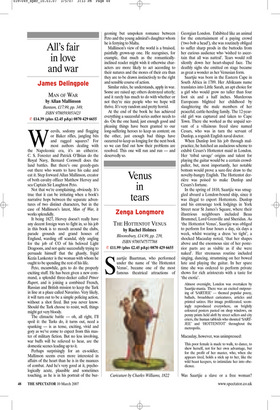Venus in tears
Zenga Longmore
THE HOTTENTOT VENUS by Rachel Holmes Bloomsbury, £14.99, pp. 239, ISBN 9780747577768 ✆ £11.99 (plus £2.45 p&p) 0870 429 6655 Saartjie Baartman, who performed under the name of ‘the Hottentot Venus’, became one of the most famous theatrical attractions of Georgian London. Exhibited like an animal for the entertainment of a paying crowd (‘two bob a head’), she was routinely obliged to suffer sharp prods in the buttocks from her curious audience who ‘wished to ascertain that all was nattral’. Tears would roll silently down her heart-shaped face. The deathly sighs she emitted on stage became as great a wonder as her Venusian form.
Saartjie was born in the Eastern Cape in South Africa in 1789. Her Afrikaans name translates into Little Sarah, an apt choice for a girl who would grow no taller than four foot six and a half inches. Murderous Europeans blighted her childhood by slaughtering the male members of her peaceful, cattle-herding family. The 12-yearold girl was captured and taken to Cape Town. There she worked as the unpaid servant of a villainous freed slave named Cesars, who was in turn the servant of Dunlop, a roguish English naval doctor.
When Dunlop lost his job through malpractice, he hatched an audacious scheme to exhibit Cesars’s Hottentot maid in London. Her ‘tribal savage’ origins and talent for playing the guitar would be a certain crowdpuller, but, most importantly, her notable bottom would prove a sure-fire draw to the novelty-hungry English. The Hottentot derrière was poised to make Dunlop and Cesars’s fortune.
In the spring of 1810, Saartjie was smuggled aboard a London-bound ship, since it was illegal to export Hottentots. Dunlop and his entourage took lodgings in York Street near St James’s Square, where their illustrious neighbours included Beau Brummel, Lord Grenville and Sheridan. As ‘the Hottentot Venus’, Saartjie was obliged to perform for four hours a day, six days a week, whilst wearing a dress ‘so tight’, a shocked Macaulay noted, ‘that her shapes above and the enormous size of her posterior parts are as visible as if she were naked’. Her strenuous routine included singing, dancing, strumming on her bowed lute and playing the guitar. In her spare time she was ordered to perform private shows for rich aristocrats with a taste for ‘the exotic’.
Almost overnight, London was overtaken by Saartjie-mania. There was an excited outpouring of ‘SARTJEE’ — themed popular poesy, ballads, broadsheet caricatures, articles and printed satires. Her image proliferated, seemingly reproduced everywhere, on brightly coloured posters pasted on shop windows, on penny prints held aloft by street sellers and city criers, the human tabloids who shouted ‘SARTJEE’ and ‘HOTTENTOT’ throughout the metropolis.
Macaulay, however, was unimpressed:
This poor female is made to walk, to dance, to shew herself, not for her own advantage, but for the profit of her master, who, when she appears tired, holds a stick up to her, like the wild beast keepers, to intimidate her into obedience.
Was Saartjie a slave or a free woman? Macaulay took Dunlop and Cesars to court, but lost the case. The defendants were absolved of any wrong-doing. Immediately after, Cesars whisked Saartjie off to Paris where slavery was legal. This is where her story becomes almost too horrible to bear. A predatory showman named Reaux offered to take over ‘La Vénus Hottentote’ from Cesars, who was glad to rid himself of the ailing girl and return to Capetown. Saartjie’s schedule now became unbearably demanding. She performed from 11 in the morning to 9 at night, then danced for private viewings, evening displays at cafés, late-night salons, parties and balls. She was frequently seen crying uncontrollably in public. Myriad pictures were painted of her in the nude. It is thought that the humiliation of being forced to stand naked before the artists pushed Saartjie to an early death. Reaux drove her on mercilessly, plying her with brandy which furthered her descent into alcoholism and illness. Saartjie was worth more dead than alive. Mad evolu tionist doctors were lying in wait, desperate to dissect her corpse in order to prove all sorts of fantastic theories. Years before Darwin, the evolutionary fantasy of dark-skinned people being akin to the ape had taken hold of Western pseudo-science. Reaux denied Saartjie all medication but alcohol, hastening her demise at the age of 26. Her body was immediately sold to the evolutionists at the Natural History Museum, and Reaux became a rich man.
Saartjie’s brain and genital organs were pickled in brandy and her bones were presumably prodded in death as they were in life. Upon the insistence of Nelson Mandela, after a 200-year wait, her skeleton was finally returned to South Africa and buried in 2002. Rachel Holmes’s biography of this unhappy woman is gripping and meticulously researched. Although little is known of what Saartjie felt or thought, her sensitive, other-worldly personality glows from the pages.



























































































 Previous page
Previous page